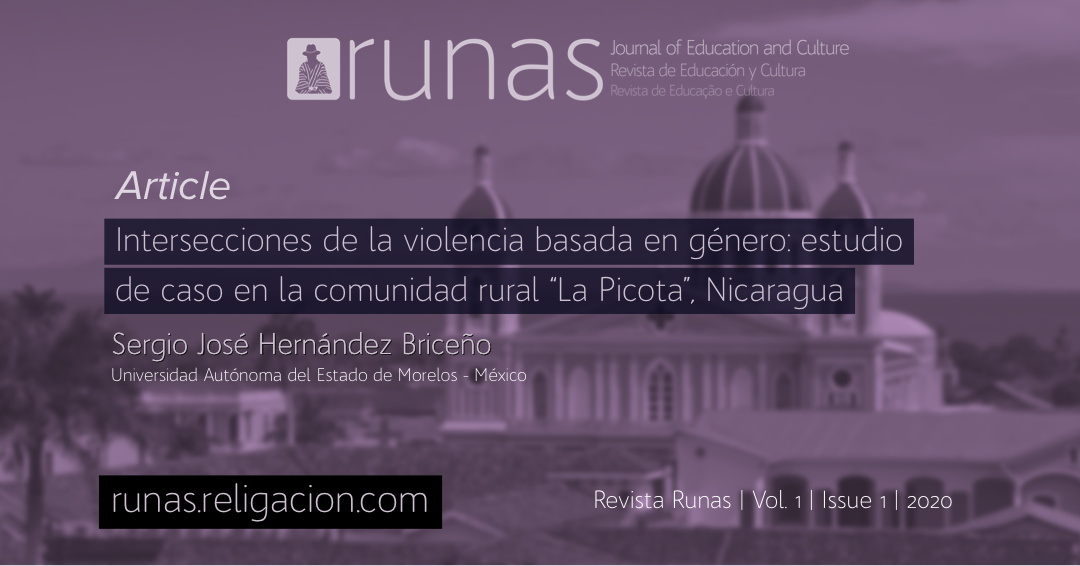Abstract
The present article is elaborated with a qualitative investigative approach, some destined to the recognition of the daily and violent experiences that the women of the La Picota community live in, located in the municipality of Chinandega - Nicaragua; thus, achieving broadening the preventive approach to gender-based violence. In the writing it was possible to understand part of the way of life in the community context of research and the opinions expressed out loud by key actors for the study; proceeding to relate the community perceptions, with the collective imagery and the theoretical precepts linked to the intersections of violence.
The methodology used to develop the article was qualitative and responds to anthropological research methods, using interviews and observation sheets and techniques (direct and participant) in order to extract information and content to understand the social problems of violence. And its intersections. The ethnographic method was applicable in order to project the community dynamics where the study is carried out. The research work also emerges as part of the author's close experience towards the research context for 4 years as a facilitator of processes for social and community development, with a psychosocial focus.
Part of the results obtained from community research showed that sociocultural patterns that violate rural women still persist, from various social, economic, ethnic, educational, age, disability, and geographical locations of their residences. This crossing of variables forces the actor's understudy to be subjected to multiple discriminations within and outside their communities. From these edges of the intersection, the interviewees were selected who responded to various age ranges, this in order to have a more global analysis of the way in which violence is experienced and exacerbated, from the relationship of the previously referenced elements.
With the analysis of the elements extracted from the key informants and the theoretical perspectives of the intersectionality of gender-based violence, it was possible to broaden the gaze towards this phenomenon that women experience and the way in which the profiles of the potential victims of this violence are examined. All this to generate a kind of diagnosis that shows where to influence in a timely manner to raise awareness about necessary changes in social behavior; some that usually justify the constant violation of rights towards women.
The current effects of the pandemic are taken into consideration and as this further aggravates, the experiences of various expressions of gender-based violence against women, some of the effects of the pandemic being constant exposure within their homes, because they are living with potential aggressors and outside their homes, where they are exposed to a virus contagion, while they carry out their corresponding commercial and popular activities. By broadening their behavior towards the current scenario and the way in which this context affects them, the contributions to a preventive culture of violence against women, in family and social contexts, will be timelier.
References
Baztán, Á. (1995). Etnografía, Metodología cualitativa en la investigación sociocultural. Editorial Boixereu Universitaria.
Barbera, L. (2016). Interseccionalidad, un “concepto viajero”: orígenes, desarrollo e implementación en la Unión Europea. Interdisciplina, 4(8), p. 105-122. http://dx.doi.org/10.22201/ceiich.24485705e.2016.8.54971
Collins, P. (2015). Intersectionality’s Definitional Dilemmas. Annual Review of Sociology, (41), pp. 1-20. https://doi.org/10.1146/annurev-soc-073014-112142
Comisión Interamericana de Derechos Humanos – CIDH (2017). Mujeres indígenas y sus derechos en las Américas. Comisión Interamericana de Derechos Humanos.
Davis, A. (1981), Mujeres, raza y clase. Comisión Europea aborda múltiples formas de discriminación: prácticas, políticas y ley. Comunidad Europea.
Feita, C. (2005). Antropología y Desarrollo rural. Contribuciones del abordaje etnográfico a los procesos de producción e implementación de políticas. Avá-Revista de antropología, (6), 1-26 http://www.redalyc.org/articulo.oa?id=169021465008
Gracia, J. (2015). Una Mirada Interseccional sobre la Violencia de Género contra las Mujeres Mayores. Oñati Socio-legal Series, 5(2), 547-569. http://opo.iisj.net/index.php/osls/article/view/423
Guajardo, G. (2015). Violencias contra las mujeres Desafíos y aprendizajes en la Cooperación Sur-Sur en América Latina y el Caribe. FLACSO Chile.
Guber, S. (1991). El salvaje metropolitano. Editorial Legasa.
Hernández, A. (2018). Opresión e interseccionalidad, ilemata, Revista Internacional de Éticas Aplicadas, (26), 275-284. https://www.dilemata.net/revista/index.php/dilemata/article/view/412000196
Marshall, C. (1989). Designing qualitative research. Sage.
Medina Montoya, M. (2004). Función social del psicólogo clínico: estado del arte. (Trabajo de grado inédito). Universidad San Buenaventura.
Muñoz, P. (2011). Violencias Intersecciones: Debates feministas y marcos teóricos en el tema de pobreza y violencia contra las Mujeres en Latinoamérica. Central America Women’s Network. https://url2.cl/374zb
OACP. (2016). Acuerdo final para la terminación del conflicto y la construcción de una paz estable y duradera. Oficina del Alto Comisionado para la Paz. https://url2.cl/ehGwk
Ordaz, R. (2015). La Interseccionalidad como Instrumento Analítico de Interpelación en la Violencia de Género. Oñati Socio-legal Series, 5(2), 596-612. http://opo.iisj.net/index.php/osls/article/view/443
ONU-Mujeres. (2017). Hacer las promesas realidad, la igualdad de género en la agenda 2030, para el Desarrollo Sostenible. ONU Mujeres. https://url2.cl/nFAIC
Platero, R. (2014), Metáforas y articulaciones para una pedagogía crítica sobre la interseccionalidad. Quaderns de Psicología, 16(1), 55-72. https://doi.org/10.5565/rev/qpsicologia.1219
Raza, H. (2017). Using a Mixed Method Approach to Discuss the Intersectionalities of Class, Education, and Gender in Natural Disasters for Rural Vulnerable Communities in Pakistan. Journal of Rural & Community Development, 12(1), 128–48. https://journals.brandonu.ca/jrcd/article/view/1338
UNFPA, COVID-19. (2020), Una lente de género; protección sexual y reproductiva salud y derechos y promoción igualdad de género. Nueva York.
UNESCO. (2017), School Violence and Bullying. Global Status Report. UNESCO.
Villabella, C. (2012), Métodos de investigación jurídica, algunas precisiones. UNAM.
Witzel, A. (1982). Procedimiento cualitativo de investigación social. Resumen y alternativas, frankfurt: campus verlag.
Witker, J. (2017). Los derechos humanos, nuevo escenario de la investigación jurídica. Boletín Mexicano de Derecho Comparado, 1(149), 979-1005. http://dx.doi.org/10.22201/iij.24484873e.2017.149.11363

This work is licensed under a Creative Commons Attribution-NonCommercial-NoDerivatives 4.0 International License.
Copyright (c) 2020 Sergio José Hernández Briceño






